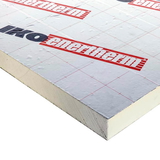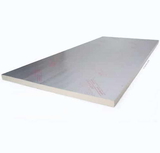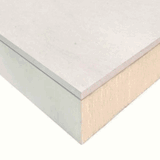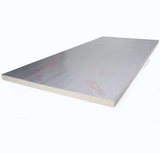- Blogs
- What Is PIR Insulation?
What Is PIR Insulation?

PIR insulation boards are used for all project types. Due to their extremely low thermal conductivity, versatility and ease of use, PIR boards have been the go-to insulation boards for many building contractors.
PIR boards can be used to insulate walls, roofs, and floors, and sometimes it is also used in cavity wall insulation. These insulation boards are incredibly strong and long-lasting; they won't sag or weaken with time.
What Is PIR Insulation? What Are They Made Of?![Celotex pir]()
PIR insulation is made of polyisocyanurate. A mixture of polyols and isocyanates under high temperature and pressure produces a thermoset polymeric substance that serves as the core of these insulation sheets. The resulting board is strong, stiff in nature, and does not melt when heated.
PIR insulation boards are about 2.4m long and about 1.2m wide, made in a range of thicknesses from 20mm to 200mm. To further increase thermal insulation by storing and enhancing heat within its fabric, a layer of low-emissivity foil is then bonded to the PIR board.
These foil facings are used to reflect heat and confine it to a certain space. For instance, when PIR boards are installed in a building's ceiling, the foil reflects the heat into the structure, warming it from the floor up. These foil-facings act as a continuous vapour barrier, thus protecting the board and the application against moisture ingress.
What Are The Uses Of PIR boards?
As mentioned earlier, PIR insulation is versatile in application. Some of the common uses of PIR boards include:
Wall Insulation - PIR insulation can be used to insulate walls. If they are BBA-approved, like some Celotex PIR boards or Iko Enertherm boards, they can also be used to insulate cavity walls.
Floor insulation - PIR boards can be used for suspended floor insulation.
Roof Insulation - PIR insulation is ideal to insulate on both pitched roof and flat roof applications.
What Are The Advantages Of PIR?
Apart from restricting the loss of warm or heated air, PIR insulation has the following advantages: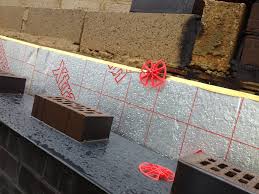
- PIR boards are cost-effective. Though it is not cheaper compared to expanded polystyrene or extruded polystyrene boards, it can cut your annual energy costs by up to 30%. Hence their costs are easily recouped within a couple of days.
- By keeping the heat indoors, it increases the energy efficiency of your home. This helps combat climate change and global warming.
- In addition to preserving indoor temperature during winters, PIR boards also help keep cool in summer by reflecting heat to the source. It will increase the sustainability and energy efficiency of your building.
- Since they give superior thermal insulation at a reduced thickness, compared to mineral wool insulation, PIR boards save floor space. This feature of PIR is especially helpful when used to insulate walls internally.
- The foil-facings on these insulation boards not only reflect heat and save energy but also act as a vapour barrier. As a result, PIR boards and the application are both protected from moisture intrusion.
- PIR boards are rarely affected by moisture and they do not sag over time. This helps these insulation boards to retain their thermal performance over time. So, PIR insulation is a long-term insulation solution.
PIR Boards At Buy Insulation Online.
At Buy Insulation Online, we have sourced some PIR boards from the most famous brands for you, like Iko, Celotex Insulations, and Xtratherm.
All of these PIR boards are made in standard sizes i.e., they are about 2.4m long and 1.2m wide. These insulation boards have foil facings on either side. They are available in varying thicknesses to help suit any project type.
How To install PIR Boards?
PIR insulation can be installed by the Dot-and-Dab technique
- The first step is to make markings on the wall where you have to install PIR boards. Mark the ceiling and floor at the board's thickness plus 10mm. For eg: if your PIR board is 50mm thick, the markings on the floor and ceilings should be made at 60mm (50mm+ 10mm). Additionally, the centre of the PIR board needs to be marked on the wall. On the wall, at every 1200mm, horizontal markings can also be placed to identify the margins of the PIR board.
- Mark and cut the boards to the appropriate size using a hand-saw. Note that PIR boards must be 15 mm shorter than the height of the wall.
- Prepare your plasterboard adhesive- Knauf Drywall adhesive by the provided directions. Apply a continuous strip of this drywall adhesive to the edge of the ceiling, the wall, and any apertures like windows and doors.
- Dab the drywall adhesive onto the wall at every 50-75mm and 250-mm-long intervals. Note that each PIR board needs three vertical rows, one in the middle and two on either side, each at least 25mm from the edge.
- Press the rear or back side of PIR boards against the dabs while supporting them with plasterboard packers. Align it with the markers on the ceiling and floor before tapping it into place.
- Using a board lifter, raise the PIR board tight to the ceiling. You can remove the lifter after the insulation board is fixed in place with plasterboard packers
PIR insulation boards can be installed using a variety of techniques. The approach is determined by insulation location on the property and its use.
To prevent thermal bridging, all boards should be tightly put together. You can further secure PIR insulation by sealing the margins with foil tapes.
Lack Of Supply Of PIR Insulation
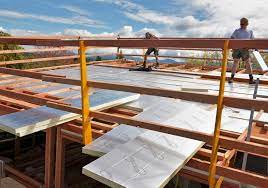 There was a severe lack of PIR insulation in the construction sector due to an insufficient supply of MDI, a compound that creates a thermal insulating film. This problem has been attributed to a lack of supply in Germany, where MDI is predominantly made.
There was a severe lack of PIR insulation in the construction sector due to an insufficient supply of MDI, a compound that creates a thermal insulating film. This problem has been attributed to a lack of supply in Germany, where MDI is predominantly made.
A chemical plant fire in Ludwigshafen in October last year caused the production of PIR boards to be stopped in the region. Other manufacturing plants have also suffered from failures to meet demand, making the shortage even worse.
Small to medium-sized builders have been affected the most, with prices rising to an unsustainable level. Large building companies are not as worried about the shortage, as they have the financial resources to make sure that PIR is affordable.
Due to the shortage in PIR, the demand for other materials such as Rockwool, XPS and EPS, has reached an all-time high. Manufacturers have had to increase production levels of these alternative materials, and this has caused a shortage in PIR boards across Europe.
The lack of supply of PIR boards continues to be a serious problem for both consumers and the construction industry. A shortage of PIR boards in one country can have disastrous consequences for the rest of the world.
In Conclusion:
Though EPS and XPS insulation boards act as effective alternatives to PIR insulation, there is no proper or more suitable alternative to PIR insulation in the market as yet. Its superior thermal insulation is what makes PIR a crowd favorite, and they are still in great demand in the construction industry.
For trade-quality PIR insulation from Celotex insulation, Xtratherm, and Iko, please visit Buy Insulation Online. In addition to PIR, we also stock mineral wool insulation, insulated plasterboards, polystyrene insulation boards, pipe lagging, ductwrap, valve covers, and much more at low cost.

Samuel Hitch
Managing Director
Buy Insulation Online.
Leave A Reply
Your feedback is greatly appreciated, please comment on our content below. Your email address will not be published. Required fields are marked *













